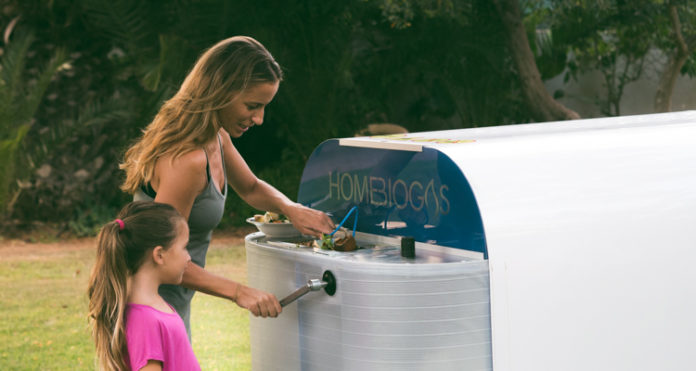
HomeBiogas is turning organic waste – food waste and animal manure – into usable cooking gas and liquid fertilizer. It eliminates 1 ton of organic waste and reduces harmful emissions equivalent to 6 tons of carbon dioxide over the course of a year. 
Every day, the 88-pound system – as easy to use as a dish-washer – can process up to 6 liters of food waste, including meat and dairy, or 15 liters of animal manure, including pet waste. It can yield about three hours worth of clean cooking gas, enough to make three meals and about 10 liters of natural liquid fertilizer.
Even as first world countries continue to waste about 220 million tons of food per year, up to four million people die from the direct and indirect effects of cooking with solid fuels, like wood, charcoal and coal.
The European Union and the Peres Center for Peace funded a pilot program in 2015 where 40 HomeBiogas systems were installed in the Palestinian village of al-Awja in the central West Bank’s Jordan Valley.
#Palestinian village uses #Israel HomeBioGas reactor as alternative source #energy http://t.co/2mMMKkuE6l #Palestine pic.twitter.com/03Y327sJFA
— Daniel Brenner (@Daniel_Brenner) August 24, 2015
“This system will be available to everyone that needs it in the developing world. It will eliminate waste, it makes clean gas, and there is no need to breathe in any smoke,” Oshik Efrati, CEO of HomeBioGas, told Reuters adding that the product could save many lives in rural areas across the world where smoke from cooking on an open fire causes severe respiratory illness and death.
HomeBiogas installiert Anlage in Waisenhaus in Uganda – https://t.co/vZFMX6mJlJ pic.twitter.com/SI1jfUPqmQ
— Audiatur Online (@Audiatur_Online) February 1, 2016
Biogas is generated by HomeBiogas through anaerobic fermentation of organic matter. The generated biogas contains mainly methane gas and carbon dioxide and is filtered to remove any unpleasant odors and toxic gases such as hydrogen sulfide. The liquid fertilizer produced is filtered by flowing via a chlorine tablet that reduces the amount of active bacteria.
HomeBiogas marketing and business development’s Ami Amir explains:
“The system operates as a continuous-flow system. The materials to be processed are fed in one end, and the gas and fertilizer are emitted from the other end. A mechanical mechanism unique to this unit regulates the gas pressure, enabling the gas to be delivered at a stable and predictable pressure, as required for reliable cooking or heating. It provides clean energy, clean fertilizer, promotes health and well-being while at the same time disposes of all of the wet, organic waste generated by the household.”
This article (This Israeli Startup is Turning Trash into Biogas Fuel. Here’s How…) is a free and open source. You have permission to republish this article under a Creative Commons license with attribution to the author and AnonHQ.com.








If you do not use all of the cooking time will it roll over to the next day? Meaning do you ever have more than 3 hours of cooking time?